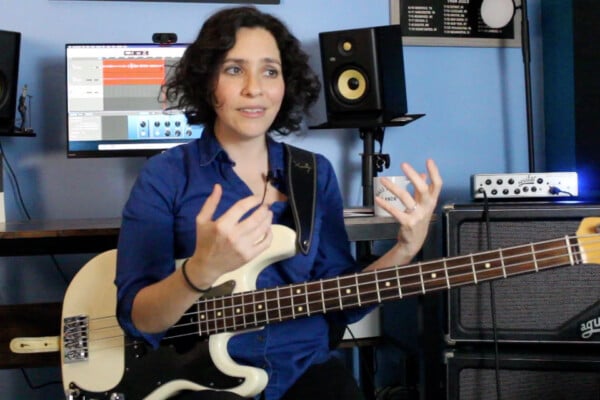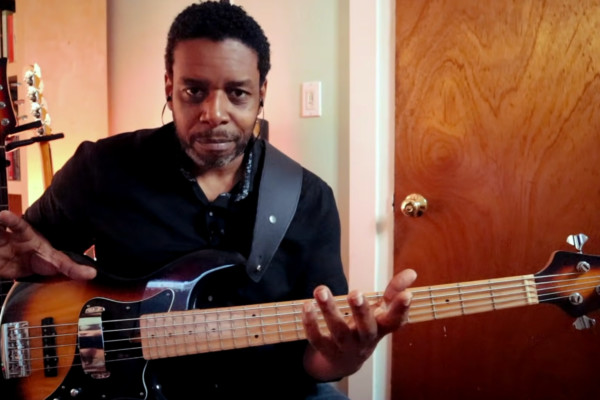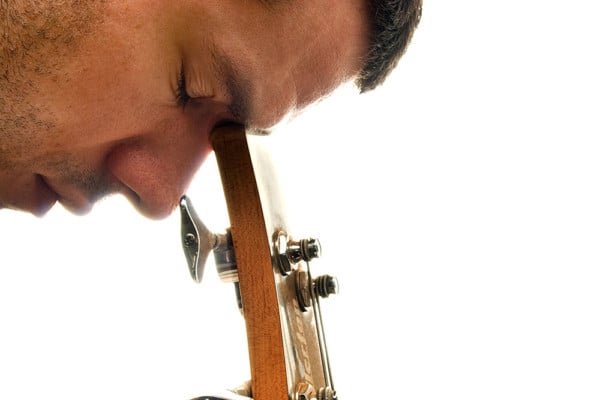Lesson Plans for the New Year

For this first installment of the new year, I thought that I would try and help motivate us all. I thought about the new year, new goals, fostering forward momentum and the dreaded new year’s resolutions popped into my head. Instead of encouraging all of us to go to the gym and stop eating pizza for breakfast, I wanted to try and provide a general lesson plan for everybody.
Now, one size does not fit all, by any means. So I’ll try and break it up into a few categories of bassists, based on your goals for the instrument. Feel free to take these suggestions and tailor them to your goals and taste. These are just broad and general suggestions of how, from my perspective, you might keep pushing in a focused and rewarding way.
The weekend warrior: For those of us who want to be a little more solid and be the best we can be when jamming with friends, but don’t plan on trying to make a living out of it. Music for its own sake.
The aspiring freelance bassist: For those who to aspire to have the ability to take almost any gig and lay it down. Solid, reliable, reading chops, knowledgable about many different styles and a bit of a chameleon. Able to jump right in a fit right in.
The working professional: This one will be aimed at players like myself. I’ve done much of the work, make a living playing music, but I could stand to start pushing myself in new directions. It’s easy to get lazy once you’re already working most nights of the week. We can spend a lot of time learning material for gigs but not much time practicing anymore. I’ve been trying to change that and re-prioritizing my time to incorporate more focused time in the shed working on my musicality and expanding my vocabulary.
The Weekend Warrior
1. Practice time. at least 30 minute / day but shoot for an ultimate goal of 1 hour / day.
The largest obstacle you have to conquer is likely muscle memory and your comfort level with your instrument in combination with your ability to immediately hear music and translate that into notes on the fretboard. To this end, you should try to get at least 30 minutes to an hour with the instrument in your hands, working through materials. The more the instrument becomes a natural extension of your body, the less you have to think about playing it, which means that you can put all of your mental energies into listening and reacting naturally to music as it is played in real time.
2. Learning tunes.
The best way to get an idea of what to play when somebody says, “this is in D. Follow me”, is to have an extensive repertoire in your catalog. The more tunes you know, the more musical points of reference you have.
You don’t necessarily need to be aware of every note you play and understand the theory behind chord creation and harmonic movement, but you need to learn what frequently played patterns sound like and associate them. For example, if you learn Flea’s bass line on the Red Hot Chili Pepper’s version of “Higher Ground” (Stevie Wonder), then you’ll have a solid point of reference for that minor pentatonic, bluesy box shape. When you hear something moving like that, you’ll immediately know what it is.
Make a play-list of tunes that you’d like to know, and/or tunes that are likely to get called in your circle of musicians. Take it slow and really listen to what you are playing in relation to the track. Don’t play too loud but rather, make the bass sit in the mix so you can hear if you get some of the notes wrong and correct things as you go. You also want to get in the habit of playing while hearing everything else happening on the track. A lot of players at this level make the mistake of listening only to themselves (and often not being aware of when they’ve gotten off track. Listen to the band as a whole as you play your lines. It’ll also help you sit in the pocket with the drummer and help to keep everybody locked in.
Set a goal of learning one tune per week (more or less depending on your abilities. If you’ve got one in the belt after two days, pick another one. Likewise, if you’re still shakey on a tune after a week, stay after it until you’ve got it. Police yourself and your progress).
I like to pick an entire album that I love and learn every bass line on it. This also helps me to try and get in the mind of that player specifically and try to ‘see’ things from their perspective (i.e.: bass line creation, approach to licks, etc..).
Make sure that you pay attention to root motion. Know what chords you are playing over. To this end, and because it is the root of most music you may be playing, I would start with some blues. Learn to hear and navigate that I-IV-V chord progression and all of its variations. Pick some Stevie Ray Vaughn, or whatever bluesy music that you may like and start there. It’ll give you a nice foundation.
3. Notes on the fretboard / scales.
Scales are a handy reference point, a good place to start learning the notes on your fretboard and a nice way to start to hear tonality (major vs. minor, etc..). If nothing else, at least get the major and minor scales under your belt. Most of the lines you play will come from one of these two scales (or with slight variations). Having these scales under your fingers can help you to see relationships as you learn and play bass lines. You will quickly realize that “Rapper’s Delight” is just a minor scale with one note changed (or the Dorian mode. minor scale with a natural 6th, to be specific). This makes the line infinitely easier to remember and will also help you when exploring bass lines of your own by giving you a framework from within which to operate.
Try and call out the notes as you play them. If nothing else, learn where every natural note is within the first five frets (A, B, C, D, E, F, G). Then, it’s only a small step if somebody says Ab, you just go to A and move down a fret. This will slowly sink in, and you’ll have them all in no time if you’re conscious about it. Just pay attention to them. It’ll help you when working tunes out with the band.
Just these three things can really start to open you up when jamming with friends or learning new tunes with your band. You’ve been training your ears by picking out bass lines from recordings, better understanding typical song forms, learning the notes and learning how scales relate to bass lines and what notes might work in a Major or Minor tonality. These things go a long way towards developing your skills enough to play with friends confidently.
The Aspiring Freelance Bassist
1. Practice time. 1-3 hours / day.
There is a lot to learn if you want to get to this level on your instrument. It requires that you have completely removed the instrument as an obstacle in your playing and have a wide musical perspective in addition to an assumed set of skills (reading, improvising, different plucking techniques to get different tones, etc..). This requires a fair amount of time and repetition. The more, the better (don’t hurt yourself though).
2. All of the above.
Make sure that you continue to transcribe tunes by ear and learn more and more music. The bigger your vocabulary, the larger your point of reference for whatever may come your way on the bandstand.
In addition to your standard scales, you should learn every mode from the major scale, melodic minor scale and harmonic minor scales. At the very least, learn them well enough to decide on which modes you resonate with over certain chord types and explore as fully as possible how to best make use of them.
3. Reading.
While there are bass superstars who can’t read and a few sidemen that I can think of, the vast majority of work that will come your way requires sight-reading skills. 95% of the gigs I do are reading gigs. In fact, my reading skills are exactly the thing that got me working when I first moved to where I live now. I quickly got known as a versatile player who could read anything you threw at him. This led to a lot of last minute sub gigs, etc.. Band leaders felt comfortable throwing a book of music in front of me on the gig and knowing that, while I might flub here or there, I was likely going to play it very well AND very musically. (the ability to play music naturally and musically while sight reading is another skills set and one that requires that you can read very well).
This is a huge bonus in recording sessions as well. Knowing that someone can come in cold, plug in, talk through the charts and get the tune in a few takes makes them imminently hireable.
My record is 22 tunes in about 6 or 7 hours (I got called in to replace a monster load of bass lines for a band that had recorded everything they had with plans to release a few albums over time). Have charts, will travel.
4. Stylistic awareness.
The broader your musical perspective, the better your playing. Listen and explore everything you can from every corner of the globe. Be on the quest to constantly expand your musical perspective. You don’t have to master Indian rhythmic vocalizations, Baltic traditional music, Afro-Cuban music and bluegrass but you should be aware of as much as you can. Explore different music from different cultures and, if you find something that resonates with you, pursue it as far as you care to. We will often learn much about rhythm and harmony, and that broader perspective will also serve to make our ideas unique and often refreshing. It keeps us engaged and moving forward. Always try to learn what it is that you don’t yet know.
5. Technique / tonal awareness.
Nobody expects everybody to be able to do everything. That’s (partially) what makes every player unique and special. There is, however, an expectation that the gun-for-hire has a few things under his belt. Make sure that you fully explore the sounds your instrument can make and how they relate to bass lines. You should explore palm muting, slapping, finger-style, pick playing – trying to emulate an upright (or tuba), etc. You don’t have to master everything but a full sonic understanding of your instrument and your fingers. Focus on how to get different sounds (without having to change basses and gear). That goes a long way toward making sure you not only have something to add to the conversation but that you can speak in the lingo of the music being made. It’s a little bit like a voice coach for an actor in a movie. They need you to sound like you came from this part of NY for the part? You can’t speak with a Boston accent. Likewise, on the session, you need to learn the finer details of sound and how that relates to the overall musical statement. It’s not just the rhythm and the notes. It’s how you play them and where you put them.
For example, I just never got any good at slapping. It was never comfortable for me. However, I did find ways to emulate slapping sounds and styles (and style of over plucking, essentially). As a result, I have successfully navigated and recorded ‘slap’ bass lines on a number of different albums. It’s all about how it sounds in the end, and I came up with a variation of it that, while it had its own flavor, performed the function necessary well enough for me to keep or get the gig. Know your instrument.
6. Improvisation.
Marcus Miller once said something that made me laugh in an interview. I’ll paraphrase here but, essentially, he was asked, “Do you think it’s more important for young players to work on bass playing than soloing?” Marcus said, “Who said they had a choice”?
As a freelance artist, you will be called upon to solo at some point. Now, nobody expects us to pull out a Metheny-like solo over changes or a Marcus style groove solo, but we need to be able to come up with some kind of musical statement. I’ve always like working on improvisation because I’m focusing on melody and using harmony in interesting ways. I figure that this also makes me a better bassist (as long as I keep my chops in check.)
Whether you transcribe solos and analyze them or practice playing scalar fragments over Real Book tunes, it’s important that you explore your melodic voice on the instrument. When given the spotlight to say what you have to say in the way you want to say it. What will you say? This comes down to your comfort level with music and your instrument. This is also just another way to explore your instrument but from outside of the realm of bass lines and grooves. Know your instrument from the lowest note to the highest. Explore chords, rhythm, melody, chops.. everything. Know your instrument and your voice on it
The Working Professional
1. Practice time.
Do as much as you can spare and still have a life.
2. All of the above.
Never stop never stopping, as Andy Samberg said. There is no finish line, and the path is endless. Be excited about the journey and travel that path enthusiastically.
3. Pick something to approach with laser-like focus.
Only you can know what this is. Find that one thing that a) you know you should be working on or b) gets you excited because it resonates with you so strongly and you just need to figure out how to do that.
For me, I’ve become fairly obsessed with Munir Hossn and his latest album, “Made in Nordeste.” I’ve been transcribing the tunes and learning tunes by ear, one by one. I’ve been picking apart lines and licks, getting hyper focused on the rhythmic stuff in there that I like so much and listening to the album over and over again. I’m focusing on internalization and less on analysis. I’m treating it as something that I’ll learn by doing, not by writing it down and taking it apart. Even if I’m not sure where the one is in a phrase, I can still sing and drum it on the table. I don’t care where the one is, for now. I can feel the music, and I can play along. I noticed that I’ve started to hear things while on gigs that I wouldn’t have heard before. I hear more rhythmic options and harmonic ideas that are very much more in Munir’s voice than my own, but they are passing through my musical filter and coming out as something of my own.
My approach and vocabulary are evolving because I’m immersing myself in something that I love and something that I’m excited about exploring. I fully believe that even just the act of being excited to grow helps us to get there. To evolve musically, we need to be passionate about what we do. I’m not talking chops; I’m talking organic musicality. Anybody can learn to hiddily-hiddily 64th notes around the fretboard given enough time, but not everybody can speak musically and organically. That is where I am focused. Ridding myself of any musical agenda beyond playing the music I want to hear when I have my bass in my hands.
This can get a bit esoteric, but only you know what you need on a deeper level. Think about the player you are, honestly and without judgment. Now think about the player you want to be, honestly and without ego-projections. Really think about the music. Now try and imagine how you can bridge those two realities. Imagine how one can lead to the other. Find connections. Find the gaps. Work to fill those gaps and foster those connections. Be the musician you want to hear. It doesn’t have to be specific, but you just have to recognize the energy.
Above all else, love what you do and have a vision for where you wan to go with it. Move with intention, clarity and focus. Beyond that? Have fun and have a fantastic 2017!
Have a question for Damian Erskine? Send it to [email protected]. Check out Damian’s instructional books, Right Hand Drive and The Improviser’s Path.



